MSC Truck: a Very Rideable Cargo Bike
Finally, a cargo bike I can comfortably ride. A proper, enormous, heavy cargo bike. In the past I've described finding this genre of bicycles challenging to handle, and some of you have suggested that I might find a longtail easier than a front-load system. You were right! But this is not your typical longtail.
The loading platform is 60cm x 60cm.
The platform can house a variety of containers. Heavy Pedals prefer to use the customisable Alu-boxes. But it can also be fitted with a more traditional cargo box, or child seats. Personally I would love an option where slatted sides could be added to the platform so that it becomes a container in of itself.
There are provisions for bungee cord attachments.
The front of the bike has a dock to which you could also attach a front rack. Overall the Truck is rated to transport 150kg (331lb) of weight, not counting the cyclist.
The height of the rack coincides with the height of a typical crate, making it possible to turn the rear into a larger platform still for oversized objects.
Heavy Pedals is a delivery service and cargo bike shop in one, and they stock all sorts of delivery cycles from different manufacturers - including long johns, bakfietsen and cargo trikes. But the MSC Truck is the one I'd be most comfortable riding on the streets at this stage, given my brief experience with the other styles. Local pricing for the Truck starts at €1999- and there is not currently a North American distributor.
The idea of the MSC Truck is similar to that of a box bike or "long john," except that the loading platform is in the rear. Designed by my friend Wolfgang Hoefler for his delivery company Heavy Pedals (in Vienna, Austria), the bike is manufactured by the Viennese Maderna Cycle Systems.
The mixte-esque frames are made of oversized steel tubing and is manufactured in Europe (Austria and Poland, as far as I understand).
The bike pictured with the aluminum box is Wolfgang's personal version with various customisations, and above is what the production version looks like with the platform empty. The wheelbase is 200cm and the total length is 265cm. The weight as pictured is 28kg (62lb). The wheels are 26". The rear rack is integrated with the frame, and the rack's tubing will fit many pannier systems including Ortlieb. The bike comes standard with a suspension fork, disk brakes, heavy duty kickstand, plastic fenders, padded vinyl saddle, and straight handlebars. There are several different gearing options, including derailleur and internally geared hub. Dynamo lighting is available as an option as well.
The platform can house a variety of containers. Heavy Pedals prefer to use the customisable Alu-boxes. But it can also be fitted with a more traditional cargo box, or child seats. Personally I would love an option where slatted sides could be added to the platform so that it becomes a container in of itself.
There are provisions for bungee cord attachments.
The front of the bike has a dock to which you could also attach a front rack. Overall the Truck is rated to transport 150kg (331lb) of weight, not counting the cyclist.
The height of the rack coincides with the height of a typical crate, making it possible to turn the rear into a larger platform still for oversized objects.
When parked, the bike is very sturdy on its double-legged kickstand; there is no wobble.
Very sturdy indeed! As I discovered when handling the Truck, there is no need to lift it either to engage or pull up the kickstand - it works via tapping it with your foot and then rolling the bike either forward or back. Even a person of very slight stature can handle it.
I was reluctant to try riding the Truck, because I did not want to overturn Wolfgang's cargo and chip his paint by crashing it. But he knows my riding style (having taught me to ride a brakeless track bike safely last summer), and assured me I'd be able to ride it. It would feel just like a regular bike, he promised. And there is no dramatic story coming, because it did. Balancing it felt the same as with a regular bike - no twitchiness when starting and braking as I had experienced with front-load bikes. It wasn't especially difficult to maneuver around the very cramped space you see me riding in. I could sense that I had a long tail, but it was intuitive what to do about it. I can't really explain it any better, other than to describe the handling as unremarkable - which, when it comes to cargo bikes, is a compliment. Though I did not ride it through the city, I would feel comfortable trying. According to Wolfgang, the handling is not any different when the platform is empty vs heavily loaded; the only difference is that it's more difficult to go uphill with the extra weight. Typical speed of a moderately loaded Truck is 20 km/h (12.5mph), though it is capable of going over 30 km/h (18.6mph) if the rider prefers to travel faster. The speed depends on the gearing you chose as well.
In addition to the fine handling, the Truck was easy to mount and dismount in a skirt thanks to the unisex frame. The adjustable saddle height (via quick-release) was convenient as well. The bike remained stable when I was walking it. A good design all around, it seems to me. It is not as "cute" as a traditional cargo bike and I am not a fan of the colour, but I have no complaints regarding its functionality. In fact, I am wondering what the benefit of a front-loading cargo bike is, if the same weight can be transported via a longtail system without impacting handling - particularly since stuff can be piled higher in the rear, where it will not block the cyclist's field of vision. This is not so much a criticism of front-load bikes, as a genuine question: What accounts for the fact that traditional makers have favoured the front-load system?
Heavy Pedals is a delivery service and cargo bike shop in one, and they stock all sorts of delivery cycles from different manufacturers - including long johns, bakfietsen and cargo trikes. But the MSC Truck is the one I'd be most comfortable riding on the streets at this stage, given my brief experience with the other styles. Local pricing for the Truck starts at €1999- and there is not currently a North American distributor.

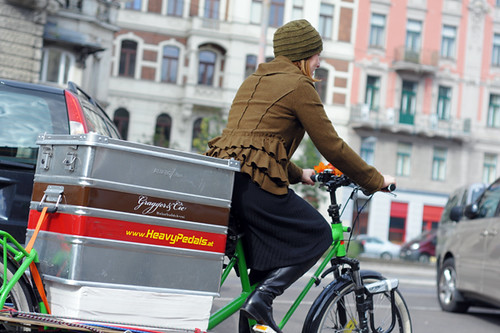
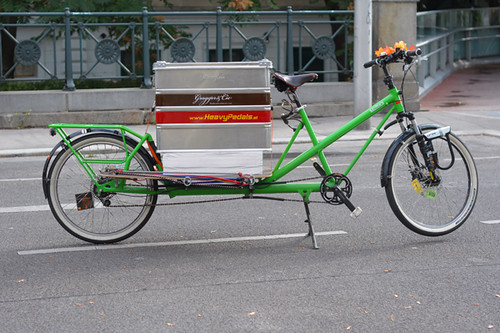

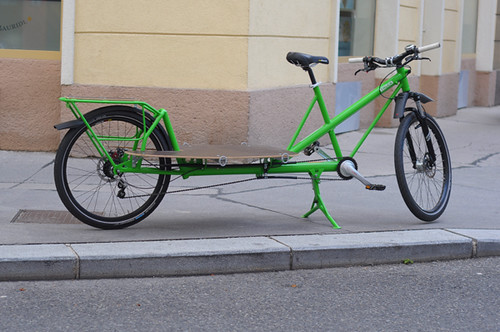
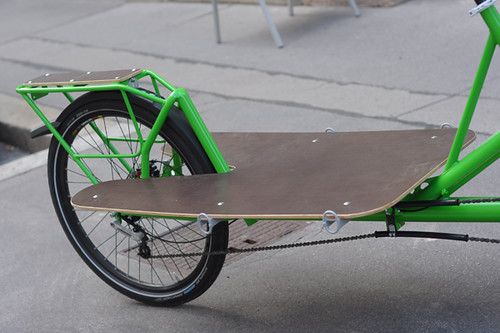

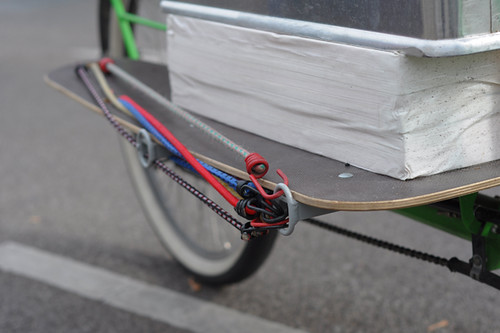
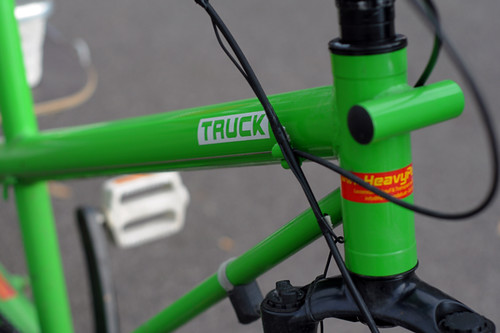


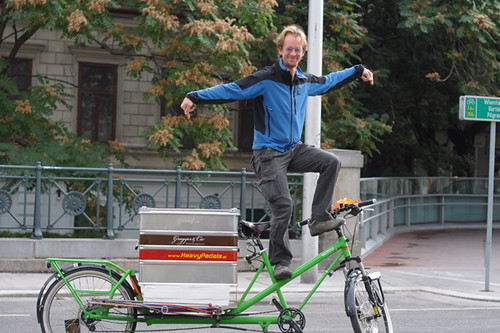
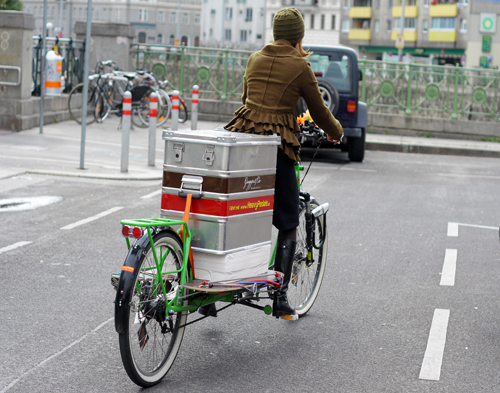
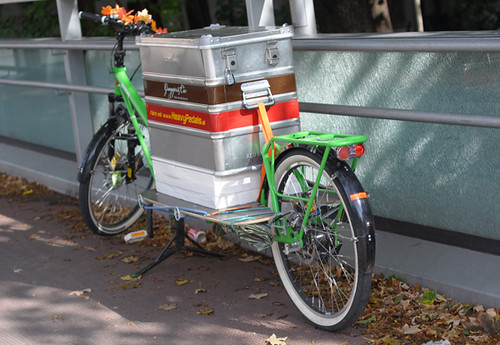
Front loaders advantage are for kids and pets where you can keep an eye on "cargo" that can free itself from where you strapped it down.
ReplyDeleteWhy a cargo bike over a trailer? Seems that a trailer + bike is less weight than a cargo bike.
Can anybody with experience shed some light on that?
I have trailer rated for 100kg - when with maximum load behind a Brompton (admittedly not exactly a tractor)it's very unstable, requiring lots of concentration and planning (braking etc). I suspect a cargo bike might be more stable - why not try it with 150kg (perhaps Wolfgang and another passenger) and see how it affects the ride?
DeleteRegular city bikes with their upright riding position have like 70% of their loaded weight on the rear wheel, so it is tempting to make it 50-50 by using a front carriage system.
ReplyDeletePutting more weight behind the rider would only lead to more broken wheel spokes and so on. It is the easiest way while not significantly modifying the bike's appearance, well at least it is to me.
Your friend's cargo gets away with it by hugely increasing the bikes wheelbase, which puts all the weight in between the wheels as opposed to on top of them.
I've ridden bakfietsen and pulled trailers, and the trailer is much worse, in my opinion. Even a long-wheelbase front-loader still steers like a bike, it lacks the surge that often accompanies trailer use, it exhibits less of the tracking problems around corners, and it is easier to negotiate through bumpy streets. The extra wheel or wheels of the trailer add rolling resistance. I'd very much like to try a longtail. They are hugely popular in Los Angeles where distances are long and traffic heavy.
ReplyDeleteit's about time. front loaders affect steering and cargo shape, porteurs being in a different class.
ReplyDeleteanti LT bias has founded in malarkey, zhe crois.
@Phil - I have experience with trailer and two longtail cargo bikes (one Xtracycle, replaced by a Big Dummy). I'm not sure that I can provide a good explanation for why I like the longtail better, but I'll try. First, for me, weight is not that big a deal. Second, more wheels tends to add more rolling resistance than piling the same weight onto two wheels (this, from Bicycling Science). Third, and this may be more of it, the trailer is not skinny, nor are the wheels. This limits where you can go with the trailer, and makes tight places and off-road more of a pain. Fourth, when you do have a heavy load (100+ pounds) it is nice to have that weight on the bike when you need to brake; you get traction, that the trailer does not.
ReplyDeleteAt least, that's the best I can come up with. The Big Dummy's a ton of fun to ride, even with a load, hauling a trailer was not.
That long bike above, is darn long, and the builtin wide rack might be annoying at times. I have wideloaders for my bike, but I only use one of them. One problem with a bike that long is that the rear end tends to skid while braking, if not loaded.
I've seen similar bikes in Montréal used by a moving company (Déménagement Myette) just last week. They also use trailers for really heavy cargo like refrigerators.
ReplyDeleteHi Phil,
ReplyDeletewith a cargo trailer, you always have to overcome the inertia of the trailer and maneuver/braking is definitely harder.
As a long-time long bike rider (w/ cargo in front or back), even trailer on the long bike, I would always prefer the "one-piece" solution.
Personally, I've never liked front load cargo bikes--or for that matter, carrying loads on the front of the bicycle--because I don't like how "busy" the bike looks/feels, don't like that the front light needs to be moved to a sub-optimum location etc. Whereas, in placing the weight on the back, the rider seems less impacted by carrying things.
ReplyDeletePlacing cargo on the front of the bike was an evolution that developed apparently for newspaper delivery cyclists in France. It's just one of many possible solutions for carrying weight on a bike, a solution that Jan Heine likes, and hence has been getting a lot of attention of late.
Good question, Phil. A bunch of us, in the 80's, built a trailer for our bikes and shared it for heavy loads. It handled a wide range of materials and weights, but we didn't have to purchase an extra bike so were always comfortable on our familiar steed.
ReplyDeleteV, I love it when you go out of town. We get to see so many interesting places and bikes! I love hearing about the bike culture in your visits, and seeing the different bikes they ride. I never get to see them here in Atlanta. I went on a two hour ride today on our busiest recreational trail. Didn't see a single bike (other than mine) that was made in Europe. All were road bikes (usually Trek) and some comfort bikes.
ReplyDeleteThanks for making my vicarious visit possible!
Phil, as a parent I tried using a trailer for utilitarian cycling and it drove me crazy even though I really recommend it for recreation. Two things that make me not like the trailer are difficulty in parking it (you have to either unhook it from the bike or twist to fit next to the bike and then lock it separately) and difficulty in walking it in any direction other than forward (left "pedestrian" turns on a busy road are a nightmare). You do not even want to attempt backing out of a narrow space. I foolishly walked it into a store once (kid was asleep in it) and it took two people to get me out.
ReplyDelete@Phil - my guess is that it's all about the handling. With a trailer you might have less control/notice it more, while a cargo bike the system can be more integrated and the handling has a better chance at being easier. Heavier cargo bikes can carry more stuff (Yuba Mundo can carry something like 400 lbs + rider). I don't own either, so this is just a guess.
ReplyDeleteDid you ride it up any hills? With enough gears, it should be able to go up almost any hill with a load, though it might be very slow.
ReplyDeleteSeems really well thought out. A cargo bike that is not cumbersome or hard to handle definitely deserves some praise indeed!
ReplyDeleteIn comparing the longtails to long johns, I think you are exaggerating the handling "problems" of the latter. It only takes a few very short rides for most people to get accustomed to steering a long john. Minutes are indeed longer than seconds, but both are negligible compared to the length of time a regular user spends on a bike.
ReplyDeleteAs Phil Miller pointed out already, if one is transporting children, it is a very big benefit to have them in front, and equidistant from the wheels. I would add that I frequently toss loose cargo into the bakfiets in a way that I would not be willing to do if it were behind me (even in a similar box), and I've had large objects piled quite high in the box in front of me without any significant impediment to vision. Do you still find it disconcerting when you can't see the front wheel?
One other thought is that a front loader has a shorter chain, which can be realistically covered with a chaincase, whereas this is something I haven't seen on a longtail.
I would guess that the traditional three-wheeled bakfietsen have the cargo platform in front because it's simpler to make a drivetrain for just one rear wheel.
I must say that Wolfgang's Truck looks much more appealing to me than any of the American-style longtails I've seen, but I still wouldn't trade in my Workcycles Cargobike for one.
Why a cargo bike over a trailer? Seems that a trailer + bike is less weight than a cargo bike.
ReplyDeleteIn my experience, weight doesn't matter much. I used a Chariot with a "normal" bike for transporting my two kids before switching to the bakfiets, which I'm certain more than doubled the weight, maybe tripling it (the bakfiets weighs in at about 100 pounds). I didn't notice much -- if any -- extra effort or time required to get around.
Apart from the trailer being not sufficiently waterproof, it was much nicer not needing to avoid potholes on three tracks instead of ~1, and it was much easier to avoid hitting the curbs when turning. Last, the ride was much smoother for the kids. Even on the Chariot with adjustable suspension, the ride was much bumpier than on the bench of the bakfiets.
Somewhere in Northern California, Ground Round Jim is sporting a smile sufficiently radiant to light up a city block.
ReplyDeleteYou could carry an impressive pack of hunt-trained standard Dachshunds on such a bicycle.
"Your friend's cargo gets away with it by hugely increasing the bikes wheelbase, which puts all the weight in between the wheels as opposed to on top of them."
ReplyDeleteWell, yes. But longjohns and bakfietsen do the same thing - the front load is not actually over the wheel, as far as I can tell.
The "broken spokes" argument does not work when the longtail is expanded like this. The "watching your child" argument does not work when transporting cargo, not children. And the "might as well use a trailer" argument does not work, because as others have mentioned, some prefer an integrated system.
To my eye, the Truck is basically a backwards longjohn, that has the same type of integrated structure, the same wheelbase and the same load capacity - only without the impacted handling.
"Placing cargo on the front of the bike was an evolution that developed apparently for newspaper delivery cyclists in France. It's just one of many possible solutions for carrying weight on a bike, a solution that Jan Heine likes, and hence has been getting a lot of attention of late."
ReplyDeleteThere is a difference between regularly sized randonneuring and city bikes that are optimised for carrying a front load, and industrial-rated front load cargo bikes. As far as I understand, Jan Heine is not a proponent of the latter. In fact, I remember him voicing one of the same concerns as I have: How do you see over the cargo, if you need to carry something really tall? With the cargo behind the cyclist, this is not an issue.
I like this design and the center stand is very impressive.
ReplyDeleteAs far as which cargo style is better, I would rather think that it comes down to personal preference.
My first choice is front loading. I like to be able to see my cargo. If something comes loose you can quickly asses and pull over to make adjustments. As for kids over cargo...kids more often hate trailers, but love front loading bikes [so they can see and enjoy the ride too].
I am not against rear loaders, trailers or longtails. I am for all of them.
Mike - The only problem I have with front loaders is the handling. I and many other cyclists I know have found it difficult, and bike shop owners tell me that this is a very typical problem. The long tail design can be a solution for that category of people. Aesthetically though, I admit that I prefer the classic box bikes - especially the old style bakfiets and longjohns.
ReplyDelete@V - re handling. The one person I know who has a box bike, said that you adapt in a little while. I tried his bike, did the expected swerves at first, and was swerving less even after the first few yards. The explanation for this was that because you are so far behind the rear wheel, you don't feel enough of the steering action, and thus you oversteer.
ReplyDeleteAnd if you have a cargo bike, sooner or later, "adapt" becomes part of the package, because not all loads are perfectly balanced and rigid.
i'm not sure i understand the watch the cargo viewpoint on a fl. maybe because you must watch it due to the design. built in straps and bags? modular system? unaffected steering? on demand carrying capacity? aesthetics?
ReplyDeletei'm smiling and grimacing.
Velouria -- Have you tried riding a long john for more than just a few minutes? I'd be really surprised if you didn't get accustomed to the handling very quickly. I recall you writing about riding the Bullitt one time, and it sounded almost exactly like the first ride I had on my bakfiets. After three or four very short rides, it felt just as natural as riding a standard bicycle. Of course, they're not all created equal, but I've only once had a load so heavy (ten dozen ears of corn + 4-year-old + large bag of vegetables) that the steering was affected, and then only slightly. Any more than that, and I think the weight would have been too much, regardless of effects on the steering.
ReplyDeleteI would also hazard a guess that the Dutch and Danish tend to use front-load bakfietsen is that, by and large, the don't need to transport gargantuan objects by bicycle. I've seen a fair number of "bike move" photos from Portland, but none from Amsterdam. Because it's silly to move by bike instead of hiring a truck.
Besides, like I said before, I have carried surprisingly tall objects in the box without any vision problems. Take a look at the photos above. That stack(?) of boxes is fairly high already, yet it doesn't even come close to the height it would have to be to obstruct your vision. The floor of a typical bakfiets is at a similar height, and the ront end of the box isn't all that far away. An object has to come surprising close to eye-level before it really starts getting in the way. At that point, I'd already be more worried about the load being top-heavy than any sight-line obstruction. Moving a refrigerator by bike is a stunt, not an everyday problem that requires a practical solution.
Velouria, i would be curious to know which "long john"-style bike you rode, since every one currently available handles quite differently from each other. Personally, I have found the extended rear bikes hard to manage since the rider moves sideways when turning as opposed to pivoting more with the rear wheel and I have found that the closer the weight is to the steered (front) wheel the better for all situations. (braking, cornering, accelerating, relaxed riding). not being able to see your cargo is another issue, but the main disadvantage i've found is the ridiculously long drivechain, adding drag, and causing quite a few drivetrain problems, (shifting, wear, etc)
ReplyDeletelooks are also another issue, as well as taking an historical perspective on carrier bicycles in general. There are quite a few reasons this design never existed until only about a decade ago. in my opinion.
Josh - I've tried the Larry vs Harry Bullitt and a vintage Danish longjohn (a year ago and spontaneously - did not write about it. I have not tried a Dutch bakfiets yet.
ReplyDeletejosh, amazing condemnation of a proven design.
ReplyDeleteyou're way off base.
merlin, the Dutch move by bike all the time in the cities, it's just no big deal to them so of course you'd never hear about it or see it unless there in person. they regularly use the huge Bakfietsen (the original three wheeled ones) to move furniture, appliances and even other Bakfietsen.
ReplyDeleteVelouria, That explains it! --the Monark has very sensitive steering which only feels familiar with heavy loads, but unloaded has a very unfamiliar feel compared to "normal" bikes. So if you rode it unloaded, i agree, it is a bike that you need to get used to. The Bullitt actually has terrible steering geometry, and its ergonomics are the same as Lance's time trial road bike (not too great for cargo hauling in the city).
ReplyDeleteThanks for the answers on the trailer vs. Cargo bike question. I don't know how much added wheel resistance, wheel-tracking and track width you'd have with a single wheel back there. The Farfarrer trailer I've been looking at actually flips over onto the handlebars when empty (I had to see it!), making it easier to park and maneuver for parking. But you all made a good argument for integrated ride and handling. Thanks much!
ReplyDelete@V: My apologies if I went off topic. I just wasn't sure whether to look seriously at cargo bikes rather than a trailer for bigger hauls.
That is a brilliant design.
ReplyDeleteTwo small questions. Why does it have a suspension fork? It seems unnecessary on this bike. The guy who designed this has a good answer I'm sure. Please ask him.
A much smaller question: How does the derailleur work against all that chain weight? Feels different? Is it a special with heavier spring?
My biggest concern with this bike is that it appears the front and rear halves are connected by just a single large tube. I would think this would allow a great deal of flex, even without a load, let alone with 331 pounds stressing the joints at each end of that single tube. I could be completely wrong, but I would think this design would be destined to fail eventually if it's as flexible as it looks.
ReplyDeleteIs it me or I cannot find any cost figures for this bike anywhere in the post?
ReplyDeletePersonnally, I'll only get into cargo bikes when there all become electric. I may be the only one, but I do not find Montreal to be a flat city.
The cargo boxes appear to be resting on a stack of Styrofoam slabs. Is this because the boxes are too long for the cargo be, need to be mounted higher ... ?
ReplyDeleteOverall it looks like a very nice cargo bicycle design. One thing that puzzles me though is the suspension fork or front shock. I really don't see the need for this feature in any of my non-cargo city bicycles. Why make pedaling a heavy bicycle more effortful by putting a front shock on it? Aren't cushy wide tires enough?
ReplyDeleteMontrealize - you mean more detailed than the figure in the last paragraph? It would depend on the gearing and extras package.
ReplyDeletehttp://ronajustine.blogspot.com/2011/07/when-you-shop-at-ikea-bring-bakfiets.html
ReplyDeleteWe move by bike all the time. You can rent bakfiets for just a few euros, while renting a van for the day is several hundred euros. Our move to a nearby village cost over 200 euros for the van rental for a single 8 hour day, but if I purchase something large from one of the thrift stores I can borrow a bakfiets for 3 euros. It will carry a sofa or refrigerator.
I've also seen my husband carry a mattress on his normal Koga Miyata. It was from IKEA and they generally pack them very small and rolled in the first place. When we bought my youngest son a new bunk bed with a desk underneath, we brought it home on 3 bikes and a trailer. Everyone carried a piece!
Re front damper and styrofoam: some answer may be found here:
ReplyDeletehttp://james.architectureburger.com/cycle/cargo.html
Scroll down to the heading "shimmy".
Remember that Vienna still has a lot of cobblestones.
V - No.
ReplyDeleteI didn't see the figure!
Re potential drivetrain problems: The people at heavy pedals have very actively been using these as delivery bicycles. I forgot the figure Wolfgang named, but there are thousands of miles on them. No drivetrain problems.
ReplyDeleteAnd re suspension fork - yes, I am guessing major cobblestones + heavy load is why.
This is a great addition to the cargo bike scene. This clearly resolves my concern with long tails: the divided cargo area. It makes sense to me that long tails tend to feel more like normal bikes, as the weight on the front wheel is more similar, no matter how much load you are carrying.
ReplyDeleteBikes were part of the technological cutting edge through the '30s, I suspect that long tails were tried. Long johns were preferred for heavy cargo in those slower & more congested cities. The advantages of a long john cargo bike was the improved handling at heavy loads (50+ kilos), since bikes tend to become floppier in the rear as one adds weight. The center handle bars of the long john provided better control when stopped or walking a large load. With heavy congestion it was easier to operate closer to others when most of the bike is in front.
Urban congestion is very different than it was a 100 years ago; the above benefits of the long john are less important today. Thus long tails have rightly become more common in today's cargo scene. In the end a cargo bike is a personal choice for specific situations. More options means more people are likely to find the cargo bike that fits their application. I hope this or a similar bike becomes available in the US, it should do well.
re: front shock, drivetrain, single tube.
ReplyDeleteThat front shock is going to get hard use. A longer tail shifts more of the rider's weight onto the front wheel. I wore mine out (on an xtracycle) in pretty short order (didn't know much about maintaining shocks, that didn't help).
Drivetrain, notice there's a support pulley part way back. It is an issue with longtails, but there's plenty of xtracycles and Big Dummy's out there with a long unsupported chain.
That's a BIG tube; strength of structural elements tends to increase with the square of the dimension (that is, if you make an i-beam twice as "tall", it is 4x as strong) and the stiffness goes with the cube. And it's only unsupported right at the cargo; there's braces and struts around the rest.
I have no problem with this bike and I am always glad to see new options come out. However, I have had extensive experience on longjohn style cargo bikes and the handling has been good enough that I can let people try them with my own children in the front. This is not because I am reckless with my children.
ReplyDeleteThe bullit does not handle the same as most others and took me quite a while to get used to. It is not my favourite.
I recommend trying a Babboe, Workcycles Bakfiets or a CETMA if you want to say that you have given longjohn style bikes an honest chance.
you need to ride a trike. the old one will be gone soon. the new one is here to stay. I promise to take the key out- you'll never know there is a motor... I'll sit in it for weight too.
ReplyDeleteA very cool addition to the cargo bike fleet. I have not been a fan of the Madsen's chain length/routing, and this looks longer still. It does nicely solve the Madsen's weird divider effect and looks torsionally stiffer to boot. Long items that would be extremely challenging on my Bullitt should be a cinch with the flatbed extensions that lead back beside the rear wheel. I'd never switch to it, but WELL DONE!
ReplyDeleteVee - I've ridden a Christiania trike, remember? There is also a Nihola here that I may try. Still have not tried a Sorte Jernhest.
ReplyDeleteground round,
ReplyDeleteok, this design gets points for its (slightly) lower manufacturing costs, resulting in a lower retail price usually, and that this design introduced many people to the "cargo bike world"--the amazing capabilities of our own bodies, a couple of wheels, and some gears, -with the introduction of the free radical kit 12 years ago.
While I am not opposed to this design, and quite like the Big Dummys and Yuba there are two things that no-one has mentioned and therefore I feel should be brought up. First and less important, this think is really really long, the rear tire is a full ~26 inches behind the mounting of an xtracycle/longtail, this means that while it may feel more normal in a strait line when you start cornering the rear end is going to cut the corners a lot making it necessarily to take corners really wide and putting you more in the way of traffic. I'm sure that this is something that you would get uses to eventually but it is worth pointing out. Second an more importantly, because the mounting platform is above the drive train it has to be higher than a front loading cargo which means that although it will never restrict you're vision, it will become top heavy much quicker, considering that the deck is at the same level as the axle, look at how low the decks on front loader are. Also to answer an earlier post, the box is on styrofoam because it is too long to fit between the frame pieces; making it more top heavy.
ReplyDeleteRe. front VS rear load
ReplyDeletethink about navigating through a small gap , it takes forward concentration, now think about it with a wide load....if that load is behind you you will have to turn around at the crucial time to see if the rear will clear, thanks but I find navigating with any type of load much easier if I can keep it up front and in the feild of veiw of my direction of travel...
Addressing the Author's question, about advantages of Bakfiets: As one whom has ridden bakfiet and long tail designs, I have a bias towards the bakfiet design. I am reading this article because the MSC Truck is the first long tail design I have seen that incorporates front suspension and appears capable of Bakfiet cargo capacity-props. The advantages to the bakfiet design are:
ReplyDelete1 Conventional chain length (rotating weight is the one area bicycle weight REALLY matters-you will have an easier time spinning the pedals in a low-cargo gear ratio-also less expensive to replace the chain.
2 consistent rear wheel traction(empty & full)
3 More favorable balance of the steering system. With Bakfiets, the handlebars are always near the overall center of mass. While handling a cargo bike, the handlebars do impart leverage on the rider, as transmitted through the axles, frame, etc. With a Bakfiet design, the leverage is distributed more evenly between center of mass and center of wheelbase, to me this balance affords a more consistent and desirable handling characteristic.
4 (personal preference) Visual Obstruction: As a daily cyclist, I find more comfort obstructing my forward field of vision than my rearward field of vision (I'm usually pointing forwards and can anticipate what's ahead. The dangerous moments when I most need visual clarity are those in which I'm looking over my shoulder). Also, there's peace of mind in seeing your cargo load-no matter how precious, and managing it while straddling the bike.